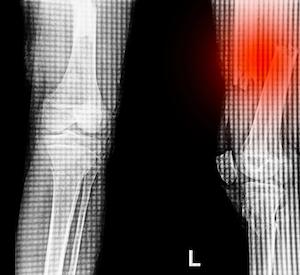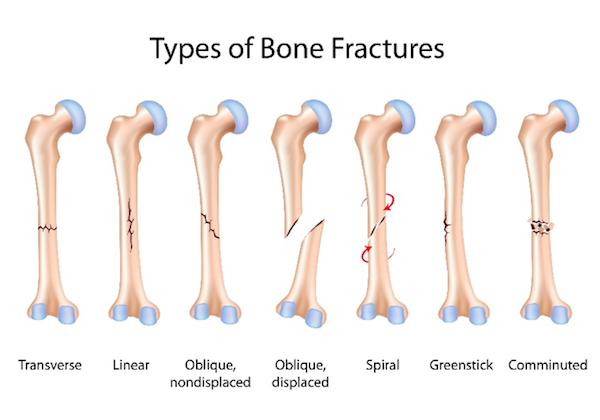Personal Injury Attorneys for Leg Fractures and Broken Bones in Naperville, IL
What is a Leg Fracture?

The leg is comprised of three bones; the femur, tibia, and fibula. The femur (thigh bone) is located above the knee and the tibia (shinbone) and fibula (calf bone) are located below the knee. A fracture in any one of these three bones is classified as a leg fracture. Leg fractures are common, with approximately 492,000 patients presenting to emergency departments every year in the United States for tibial fractures alone. A broken leg can be extremely painful and may limit your ability to perform certain activities for work and daily living. If you believe that you have fractured your leg it is important to seek medical attention as soon as possible to receive prompt diagnosis and treatment to ensure proper healing.
How Does a Leg Fracture Occur?
Leg fractures are most commonly caused by motor vehicle accidents, slip and falls, work injuries, and sports-related injuries. However, due to varying degrees in strength between the leg bones, high-energy trauma, such as from a motor vehicle accident, will be required to fracture the very strong femur, as opposed to the weaker tibia and fibula, that can be fractured from lower energy trauma produced from sports-related injuries or falls.
What is a leg Fracture Settlement Worth?
The settlement value of a leg fracture may be difficult to determine before reviewing the medical evidence, such as medical records and bills, and having an understanding of the theory of liability. The value of leg fractures can vary from case to case, depending on the type of fracture, the severity of the fracture, the likelihood of permanency, and the treatment provided. Generally, damages for past and future pain and suffering, loss of a normal life, past and future medical bills, and wage loss can be obtained in a leg fracture settlement. However, a leg fracture injury settlement can be diminished based on whether a plaintiff’s own negligence (or “comparative fault”) contributed to the injury, or when there are pre-existing medical conditions that may also have led to the injury or need for treatment.
Some of Our Firm’s Recent Leg Fracture Settlements
Motorcycle accident, negligence. DuPage County, Illinois. Settlement for $435,000 was reached on behalf of a client involved in a motorcycle accident. The client suffered severe injuries, including an open tibia fracture with an associated fibular fracture. The case settled after a pre-trial conference with the at-fault party’s two insurance carriers.
Sports injury, negligence. DuPage County, Illinois. Settlement for $215,000 was reached on behalf of a client who was injured at a local sports club. As a result of the sports club’s negligence and failure to supervise, the client suffered a tibial fracture and a displaced tibia/fibula fracture, which required surgery. Settlement was reached with the sports club’s insurance carrier, Philadelphia Insurance Companies.
Premises liability, negligence. DuPage County, Illinois. Settlement for $200,000 was reached on behalf of a woman who was injured as a result of a sidewalk defect. The sidewalk defect caused the woman to fall and suffer a distal fibula fracture. As a result of her injuries, the woman underwent surgery to stabilize her fracture.
What are the Symptoms of a Leg Fracture?
Symptoms of a leg fracture may vary depending on the severity and type of fracture. Signs and symptoms that can accompany a leg fracture include:
- Severe pain
- Pain that may worsen with movement of the leg
- Swelling
- Tenderness
- Bruising
- Inability to walk or bear weight on the leg
- Tingling or numbness in the foot (if fracture caused neurovascular damage)
- Leg appears deformed
- Leg appears shortened
How is a Leg Fracture Diagnosed?
Initially, your physician will perform a physical examination. During the examination, your physician will visually inspect your leg for signs and symptoms of a fracture such as swelling, bruising, and deformities. Your physician will then proceed to palpate your leg noting any abnormalities and test for sensation and movement in your leg and foot. After the physical exam, your physician will order imaging tests to pinpoint the location of the fracture, as well as to classify the type of fracture. An X-ray is the most common imaging test used to evaluate a fracture. X-rays provide clear images of leg bones helping physicians identify the type of fracture and its location. Occasionally, your physician may recommend more detailed images using a computerized tomography scan (CT scan) or magnetic resonance imaging (MRI). A computerized tomography scan and magnetic resonance imaging can help your physician identify subtle fractures and assess injuries to the surrounding soft tissues.
Types of Leg Fractures
There are many types of leg fractures and they vary depending on the type and amount of force causing the fracture. The fractured bone may remain in anatomical alignment (non-displaced fracture), shift out of anatomical alignment (displaced fracture), or break into several pieces (comminuted fracture). The skin at the fracture site may remain intact (closed fracture) or the bone may puncture through the skin (open fracture). Leg fractures are typically classified based on the following:
Location: The femur, tibia, and fibula are divided into three segments: proximal, middle, and distal. A fracture can be partly classified based on its location in one of these segments of the bone. For example, a fracture in the tibia that is closer to the knee would be classified as a fracture in the proximal end and a fracture closer to the ankle would be classified as a fracture in the distal end of the tibia.
Pattern: The bone can fracture in different directions such as crosswise, lengthwise, or in the middle. Some examples of this include transverse fractures (the bone breaks in a straight horizontal line), oblique fractures (the bone breaks in an angled line), or spiral fractures (the fracture line encircles the bone like stripes on a candy cane).

Open vs Closed: An open/compound fracture occurs when the fractured bone punctures through the skin. A closed fracture occurs when the skin around the fracture site remains intact.
Treatments for Leg Fractures
The primary treatment goal of a leg fracture is to ensure proper anatomical alignment of the fractured bone and then immobilize the fractured bone to allow proper healing. The methods used to achieve this will depend on the bone fractured (femur, tibia, or fibula), the location of the fracture (proximal, middle, distal), and the type of fracture (comminuted, open vs closed, displaced vs non-displaced, etc.).
Non-surgical treatment options: If the fractured bone remains in alignment (non-displaced fracture), then a splint or cast may be applied to achieve immobilization of the leg. If the fracture causes the bone to become misaligned (displaced fracture), then your physician must realign the fractured bone in a process called reduction before a cast or splint can be applied.
Surgical treatment options: Certain types of fractures require surgical intervention to realign the bone and to maintain alignment of the bone during the healing process. This type of surgical intervention is known as open reduction (realignment of the fractured bone through surgery) and internal fixation (maintaining bone alignment through surgical implants such as pins, screws, metal plates, and stabilizing rods). Open reduction and internal fixation devices may be necessary if you have the following injuries:
- Comminuted fracture (bone is broken into several pieces)
- Displaced fracture (bone is misaligned due to fracture)
- Multiple fractures
- Intra-articular fracture (fracture that extends into a joint)
- Loose bone fragments that could enter a joint
- Damage to the surrounding ligaments
- A fracture in particular areas of your leg, such as your femur (thighbone)
- A fracture that is the result of a crushing accident
After the cast and/or internal fixation devices are removed most patients will require rehabilitation exercises and/or physical therapy to reduce stiffness, restore muscle strength, joint motion, and flexibility. However, in some cases, surgical implantation devices, such as pins, screws, metal plants, and rods, may need to be removed in a second surgery. After the surgical hardware removal surgery, a physician may order an additional course of physical therapy to reduce surgical scar stiffness and improve muscle strength.
Contact the Naperville Personal Injury Lawyers at The Law Offices of John J. Malm & Associates
The knowledgeable attorneys at John J. Malm & Associates have successfully handled complicated cases for our clients who have suffered leg fractures. We are a team of experienced personal injury lawyers who represent individuals and families who have suffered an injury or loss due to an accident. You may be entitled to a substantial settlement if you have been injured. Call 630-527-4177, or 312-422-6855, and speak with Attorney John J. Malm and his team today.









